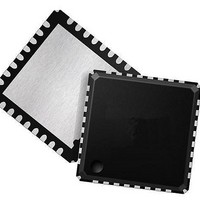LAN88710_samples SMSC, LAN88710_samples Datasheet - Page 39

LAN88710_samples
Manufacturer Part Number
LAN88710_samples
Description
Ethernet ICs MII/RMII 10/100 Automot Transceiver
Manufacturer
SMSC
Datasheet
1.LAN88710BM_SAMPLES.pdf
(80 pages)
Specifications of LAN88710_samples
Ethernet Connection Type
10BASE-T, 100BASE-TX
Minimum Operating Temperature
- 40 C
Mounting Style
SMD/SMT
Product
Ethernet Transceivers
Standard Supported
IEEE802.3, IEEE802.3u
Supply Voltage (max)
3.6 V
Supply Voltage (min)
1.6 V
Maximum Operating Temperature
+ 85 C
Package / Case
QFN-32
Lead Free Status / RoHS Status
Lead free / RoHS Compliant
Small Footprint MII/RMII 10/100 Ethernet Transceiver for Automotive Applications
Datasheet
SMSC LAN88710AM/LAN88710BM
3.7.3
3.7.4
3.7.4.1
3.7.4.2
RMIISEL: MII/RMII Mode Configuration
MII or RMII mode selection is latched on the rising edge of the internal reset (nRST) based on the
strapping of the RMIISEL configuration strap. The default mode is MII (via the internal pull-down
resistor). To select RMII mode, pull the RMIISEL configuration strap high with an external resistor to
VDDIO.
When the nRST pin is deasserted, the
to the RMIISEL configuration strap. The mode is then configured by the register bit value. When a soft
reset occurs via the
controlled by the
no affect.
Refer to
modes.
REGOFF: Internal +1.2 V Regulator Configuration
The incorporation of flexPWR technology provides the ability to disable the internal +1.2 V regulator.
When the regulator is disabled, an external +1.2 V must be supplied to the VDDCR pin. Disabling the
internal +1.2 V regulator makes it possible to reduce total system power, since an external switching
regulator with greater efficiency (versus the internal linear regulator) can be used to provide +1.2 V to
the transceiver circuitry.
Note: Because the REGOFF configuration strap shares functionality with the LED1 pin, proper
Disabling the Internal +1.2 V Regulator
To disable the +1.2 V internal regulator, a pull-up strapping resistor should be connected from the
REGOFF configuration strap to VDD2A. At power-on, after both VDDIO and VDD2A are within
specification, the transceiver will sample REGOFF to determine whether the internal regulator should
turn on. If the pin is sampled at a voltage greater than V
the system must supply +1.2 V to the VDDCR pin. The VDDIO voltage must be at least 80% of the
operating voltage level (1.44 V when operating at 1.8 V, 2.0 V when operating at 2.5 V, 2.64 V when
operating at 3.3 V) before voltage is applied to VDDCR. As described in
REGOFF is left floating or connected to VSS, the internal regulator is enabled and the system is not
required to supply +1.2 V to the VDDCR pin.
Enabling the Internal +1.2 V Regulator
The +1.2 V for VDDCR is supplied by the on-chip regulator unless the transceiver is configured for the
regulator off mode using the REGOFF configuration strap as described in
the internal +1.2 V regulator is enabled when REGOFF is floating (due to the internal pull-down
resistor). During power-on, if REGOFF is sampled below V
turn on and operate with power from the VDD2A pin.
consideration must also be given to the LED polarity. Refer to
LED1 Polarity Selection," on page 41
REGOFF and the LED1 polarity.
Section 3.4, "MAC Interface," on page 31
MIIMODE
Soft Reset
bit of the
bit of the
DATASHEET
Special Modes Register
MIIMODE
39
Basic Control
for additional information on the relation between
bit of the
for additional information on MII and RMII
IH
Register, the MII or RMII mode selection is
Special Modes Register
, then the internal regulator is disabled and
IL
and the RMIISEL configuration strap has
, then the internal +1.2 V regulator will
Section 3.8.1.1, "REGOFF and
Section
Section
Revision 1.1 (05-26-10)
is loaded according
3.7.4.1. By default,
3.7.4.2, when












